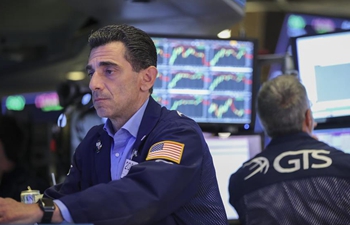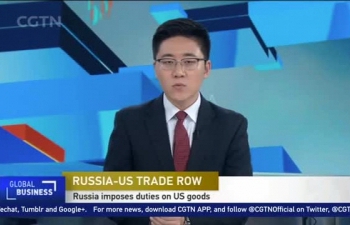by Xinhua writers Wang Wen, Yang Shilong, Zhang Mocheng
PORTLAND, the United States, July 6 (Xinhua) -- Tom Adams pulled out an eight-pound lobster, which, with its claws swinging out and body stretching, seemed to be ready for a fight.
"He's strong and healthy enough to make it to China," said Adams, owner of Maine Coast Company, a wholesale lobster supplier.
Last year, the company shipped more than 7 million pounds of live lobsters abroad and about 25 percent of the feisty ones went to Chinese mainland.
Having shipped lobsters to China for six years, Adams sees a huge market potential in China, especially when its second-tier cities started to show a great appetite for seafood. He is expanding the company's facilities in York, which can already hold 160,000 pounds of live lobsters, hoping to be able to handle more and then ship more to the world's fastest expanding lobster market.
But U.S. President Donald Trump's tariff scheme against China may well ruin his plan.
Trump has claimed that "trade wars are good and easy to win," vowing that temporary disruption will end in better terms for American businesses. On the contrary, however, the trade war he unilaterally pursues will deal Maine's lobster industry a heavy blow.
On Friday, the United States confirmed that a 25-percent additional tariff on Chinese products worth 34 billion U.S. dollars would become effective on Friday, targeting Chinese products from sectors like aerospace, IT and auto parts.
In response, China's customs authority announced that additional tariffs on imports of equal worth from the United States, including agricultural products, vehicles and aquatic products, also took effect on the same day. Lobsters are on the list.
Lobsters harvested in the United States and Canada are of the same species and the same to Chinese consumers.
China's tariff on Canadian lobsters dropped to 7 percent at the beginning of this month, while the tariff on U.S. lobsters has risen to 40 percent.
The huge price disadvantage, if lasting long, could wipe out U.S. lobster dealers' sales to China.
One could already see the tariffs' huge impact on the industry when Canada inked a trade deal with the European Union (EU).
In September 2017, the EU started to give Canadian live lobsters zero tariff while still placing an 8 percent tariff on U.S. lobsters.
"It has drastically affected our 2018 sales to Europe," said Adams.
Adams and other lobster dealers had to put strenous efforts to open the Chinese consumer market, which makes losing the market in such a fast and "easy" way is too hard to accept.
Adams founded Maine Coast Company in 2011 and started shipping goods to China in 2013. Adams networked in the United States with Asian customers he was already dealing with at first and the company's first shipments to China were made possible through those customers who had contacts in China.
The company then started traveling to trade shows in the Chinese coastal city of Qingdao and visiting big cities like Beijing, Shanghai and Guangzhou, and developed a customer base little by little. By now Maine Coast Company has more than 20 Chinese customers, including restaurants, chained-brand hotels, and supermarkets.
Adams said transportation is key to the live lobster industry."We tell people often that Maine Coast is sometimes as much as a logistics company as we are a lobster company."
His company buys lobsters directly from fishermen on the coast of Maine and throughout Canada. It then brings the lobsters into its facilities in York, Maine or Boston, letting them strengthen in a cold water tank system. Typically it takes two or three days for the lobsters to become strong enough for shipment to China. It usually takes 36 to 60 hours for the lobsters to reach their final destinations in China.
It also takes time and effort for the lobster dealer to educate the market.
"We have as a company made a conscious decision to hire people with language skills both in Europe and Asian countries. We found that it's very beneficial and it shows respect for the customers we're dealing with in other countries," said Adams.
Each year, the company has more than 10 visits from various Chinese partners to its holding facilities in York, Maine and Boston.
"They want to come meet us face to face, just like we traveled to China to meet our customers," said Adams, who also tells its customers how to keep lobsters live and healthy.
Now that U.S. lobsters are put in a price disadvantage compared with Canadian lobsters, the only competitive edge the U.S. lobster industry can cling on to is its year-round supply in addition to more airlifting out of U.S. airports. Most Canadian fisheries are open in winter and close in other seasons.
Some of the dealers are disheartened, knowing what is left of their advantage can not offset the impact of the price spike.
Losers in this U.S.-China trade war will include small family businesses and blue-collar workers. Maine's lobster wholesalers and processors employ 4,000 to 5,000 people. Much of the work -- grading, sorting and packing lobsters -- is highly physical. Maine also licenses about 4,500 lobster fishermen, limiting them to one boat and one set of gear. Each boat has one or two crew members.
"Hopefully we could resolve that situation between the United States and China as fast as possible because it will have a direct impact on both our sales here at Maine Coast (and) the U.S. lobster industry, and our customers in China's preference of doing business," said Adams.













